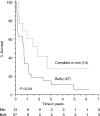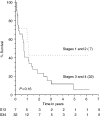Carcinosarcoma of the ovary
- PMID: 12618869
- PMCID: PMC2376340
- DOI: 10.1038/sj.bjc.6600770
Carcinosarcoma of the ovary
Abstract
We report our experience in the management of patients with carcinosarcoma of the ovary, a rare but aggressive variant of ovarian cancer. Forty patients were treated at a single centre, which is the largest reported series. The median age at diagnosis was 65 years (range 45-86) and the median Karnofsky performance (KP) status was 70. Thirty-two patients (80%) presented with FIGO stage III or IV disease. Twenty-four had heterologous and 14 homologous carcinosarcoma on review of histopathology, but there was no significant difference in survival between these groups (P=0.28). Twenty-seven of the 40 patients had bulk residual disease present after surgery and this was associated with a worse prognosis (P=0.045). Chemotherapy was given to 32 patients (80%) of whom 26 (81%) received platinum-based regimens. Of these 32 patients, three (9.4%) achieved a complete response (CR), 10 (31%) a partial response (PR), five (16%) had stable disease, 10 (31%) had progressive disease and four were not assessable. Of the 19 patients who had a CR, PR or stable disease after chemotherapy or were unevaluable (stage Ic), the median survival was 29.6 months. Currently, seven patients are still alive although one has cancer. The overall censored median survival was 8.7 months after a median follow-up of 34 months, and the 1- and 5-year survival were 40 and 7.5%, respectively.
Figures


References
-
- Calame JJ, Schaberg A (1989) Solid teratomas and mixed mullerian tumours of the ovary: a clinical, histological and immunocytochemical comparative study. Gynaecol Oncol 33: 212–221. - PubMed
-
- Chang J, Sharpe JC, A'Hern RP, Fisher C, Blake P, Shepherd J, Gore ME (1995) Carcinosarcoma of the ovary: incidence, prognosis, treatment and survival of patients. Ann Oncol 6: 775–758 - PubMed
-
- Hanjani P, Peterson RO, Lipton SE, Nolte SA (1983) Malignant mixed mesodermal tumours and carcinosarcoma of the ovary: report of eight cases and review of literature. Obstet Gynaecol Surv 38: 537–545 - PubMed
-
- Iakovleva IA, Shendereva TS (1978) Carcinosarcoma of the uterus and ovaries. Ark Patol 40: 59–65 - PubMed
-
- Melilli GA, Di-Vagno G, Cormio G, Greco P, Fontana A, Carriero C, Selvaggi L (1999) La chemioterapia nel trattamento del carcinsarcoma dell'ovaio. Minerva Ginecol 51: 445–448 - PubMed
MeSH terms
Substances
LinkOut - more resources
Full Text Sources
Medical
Research Materials

